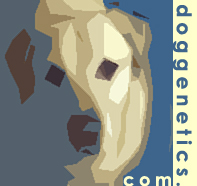
Genetic Parameters: A Brief Non-Statistical Introduction
Liz Hare, PhD
LizHare@DogGenetics.com
"Genetic parameters" are a set of statistics we use when talking about quantitative traits. A statistic is just something we want to measure. These are traits that vary continuously, like weight, PennHip score or milk production, and they are more complex to study than simply-inherited traits, like the presence or absence of PRA. We're looking at a whole continuum, rather than a yes-or-no answer. We tend to use probability and statistics to describe the inheritance of complex traits. When I say this is a "non-statistical" introduction, I mean that I'm going to try to stay away from formulas and jargon, and talk about these concepts as simply as I can.
The first thing that concerns us when we study a single trait is the variance of the values of the trait in the population. The variance is a number that addresses two questions: How much does the value of the trait vary (do all animals have a similar value for the trait or do they vary a great deal) and the relative frequencies with which the different values occur in the population.
We are able to "partition" the variance using statistical models into portions that are due to different factors. It's most common to figure out what proportion of the variance is due to genetic factors and what proportion is due to environmental factors (things like nutrition and maternal care). From this, we can figure out a statistic that you will see often, the heritability of a trait. The heritability is the proportion of the total variance that is due to genetic, rather than environmental, factors. So, if the heritability of litter size is 0.30, we say that approximately 30% of the variation is due to genetic factors, and about 70% is due to environmental factors (in this case season, year, and the parity of the dam). If we want we can further break down the genetic variance into components due to the action of alleles (epistasis; additive variance) and genetic variance due to the dominance of some alleles over others (dominance variance). But the concept of heritability is the one you will see the most often in studies of complex traits in dogs, from hip dysplasia to deafness to hunting ability.
Sometimes, we use one model to study the variation in more than one trait. This provides with the information we talked about above, but adds something new and interesting. We can now look at the covariance between two or more traits. How, in general, do the values of trait 1 relate to the values of trait 2? Why do we care?
Often, traits are correlated, meaning that the covariance between the traits is important. You would expect, for example, to see a positive correlation between the two measures of hip joint quality obtained by the OFA and PennHip methods. Probably, if you select for improvement in one, the other will improve as well. Sometimes traits are negatively correlated-- when one goes up, the other goes down. If we are trying to breed, say, smaller bitches but we want them to have bigger litters, we're going to run into problems because these traits are probably negatively correlated. The reason it's important to keep these possible correlations in mind is that often they are not as obvious as the traits I've mentioned here. So when you're selecting for multiple traits, it's important to consider their covariance.